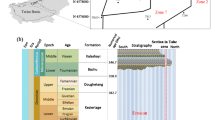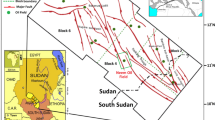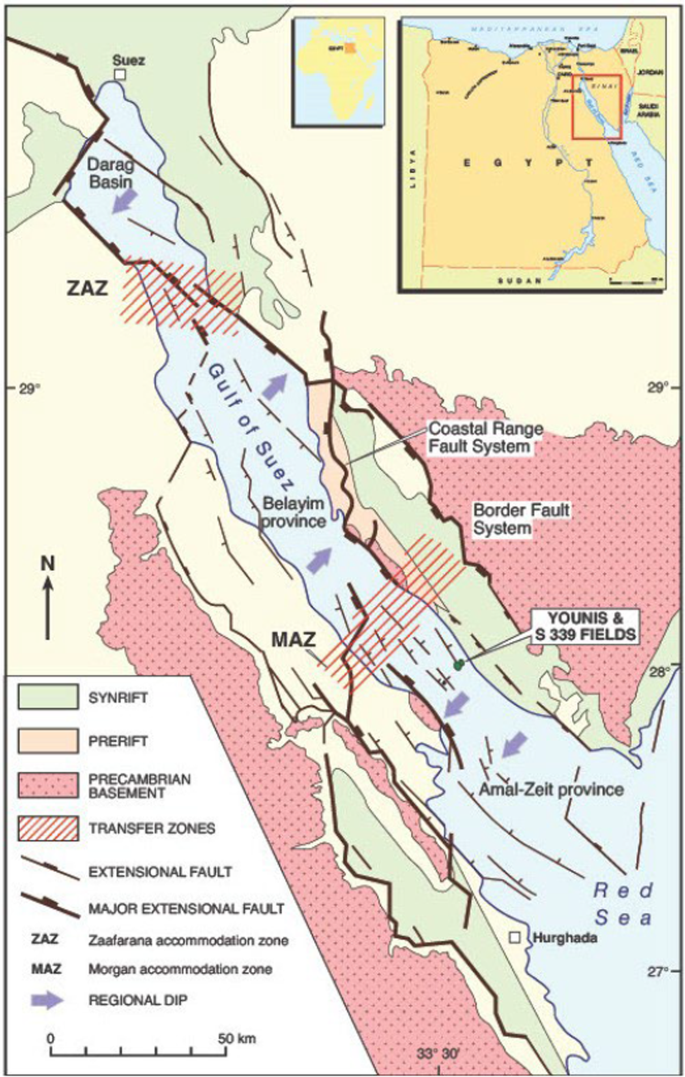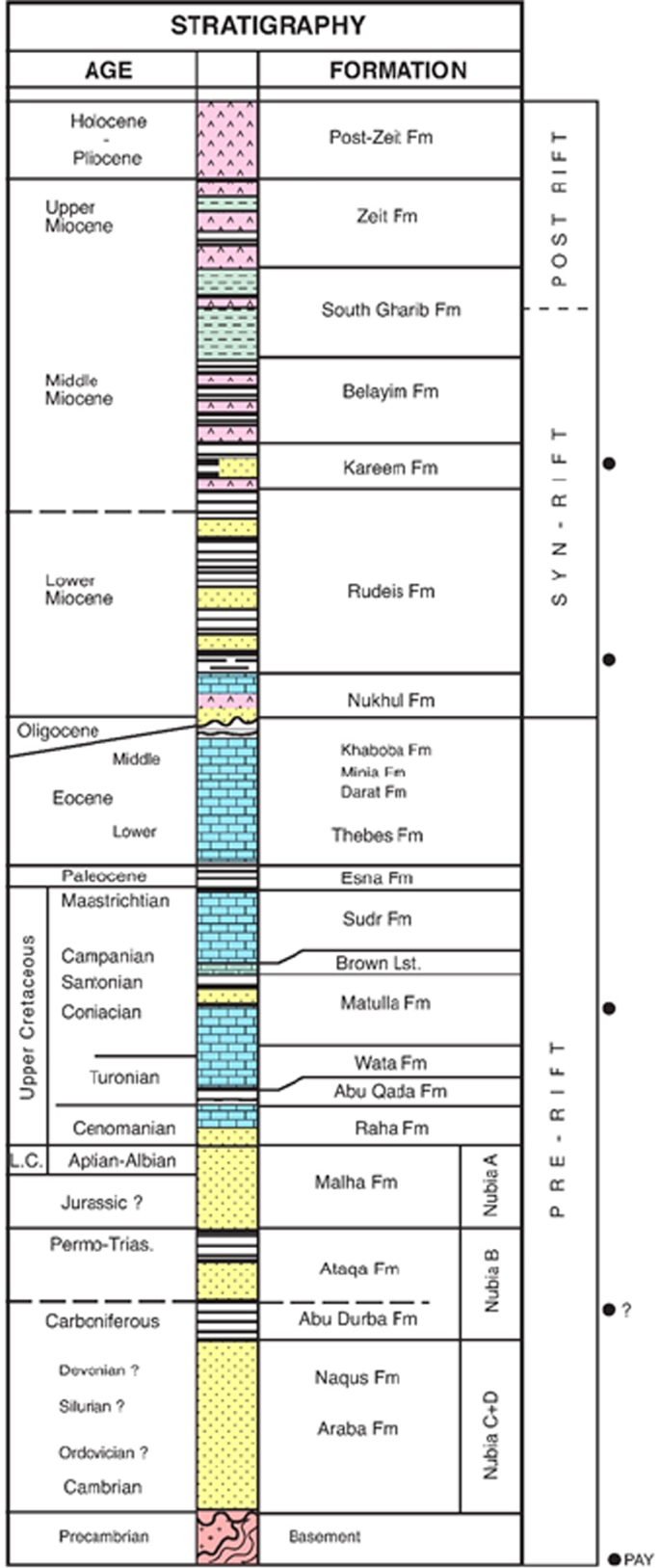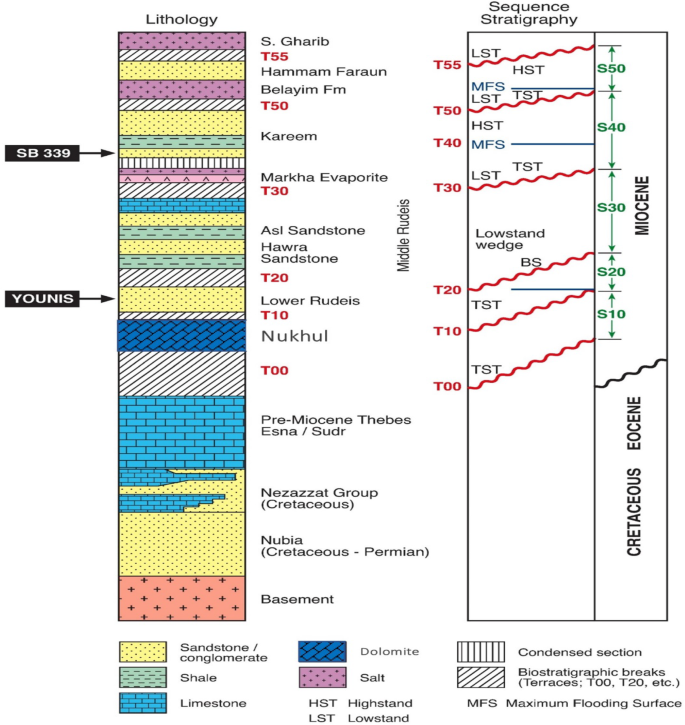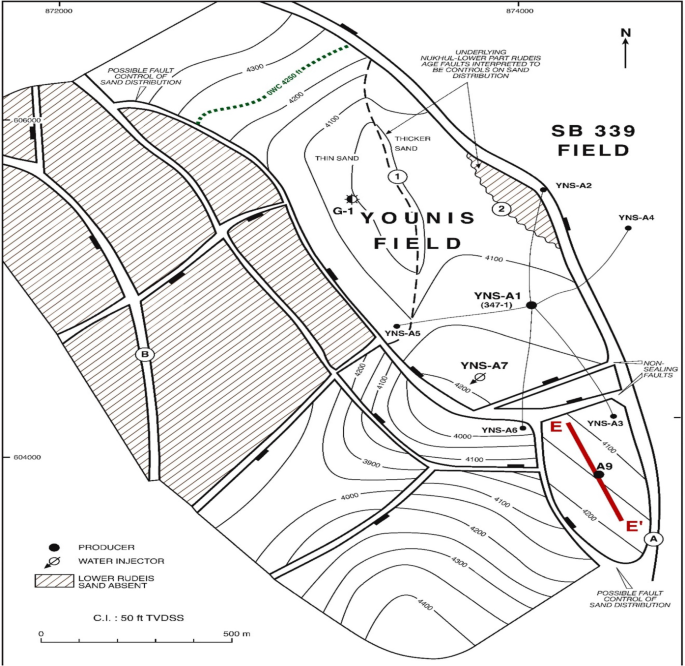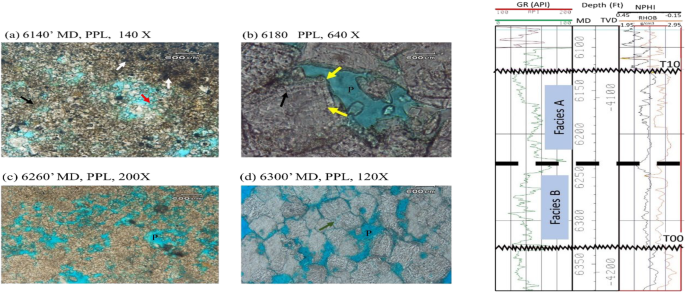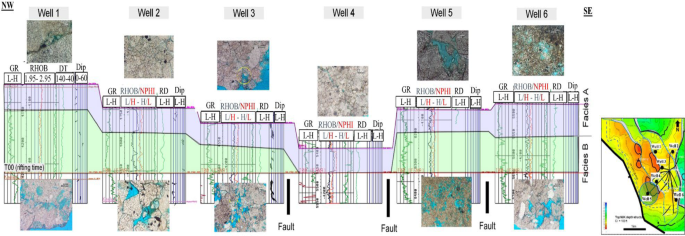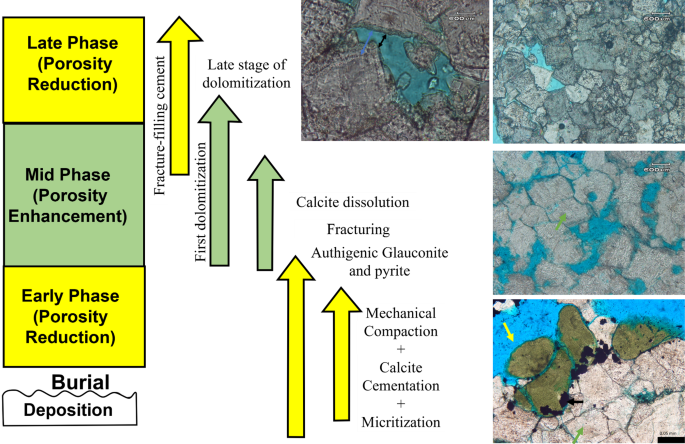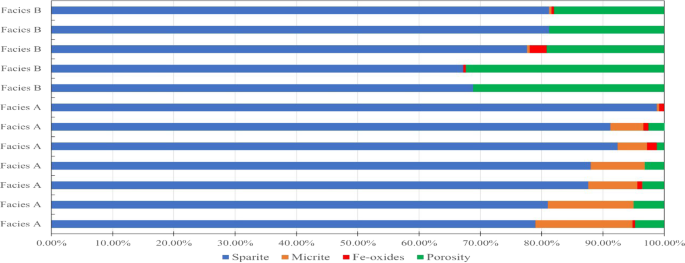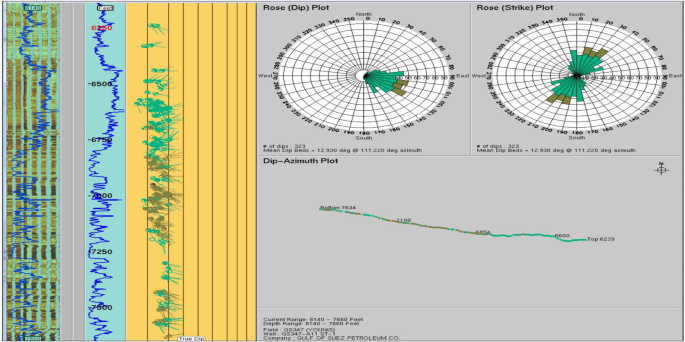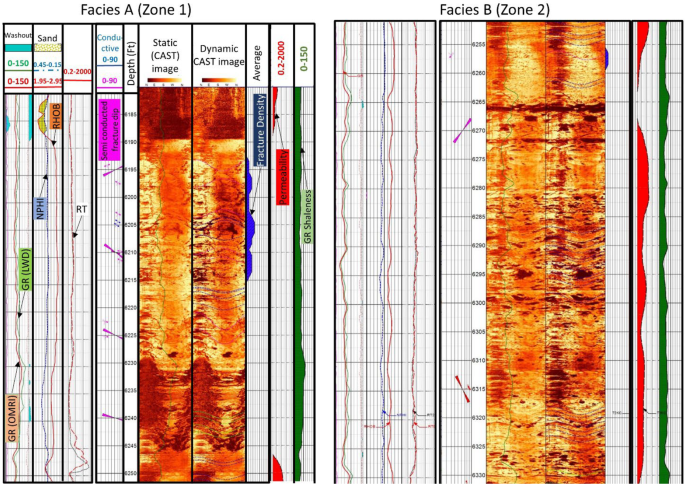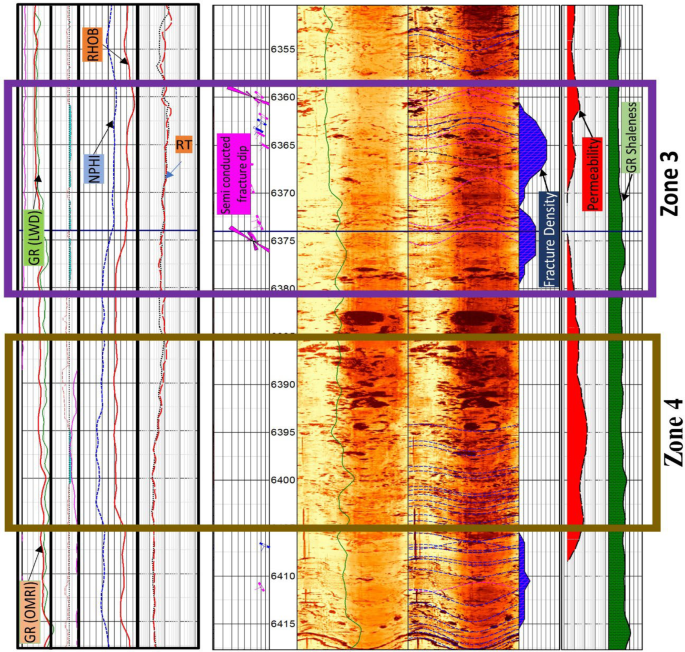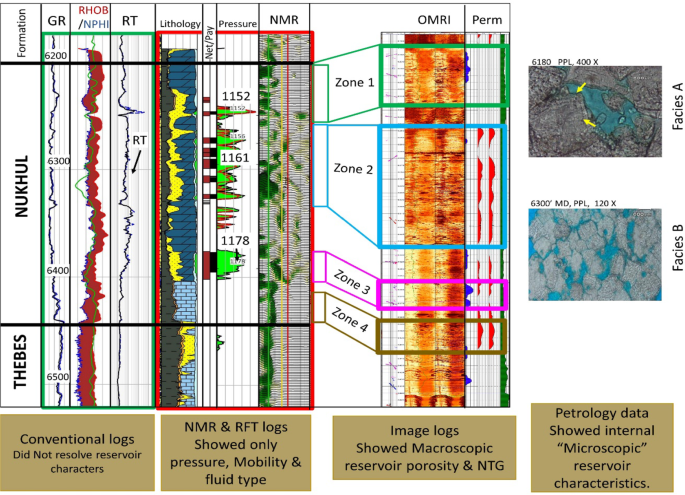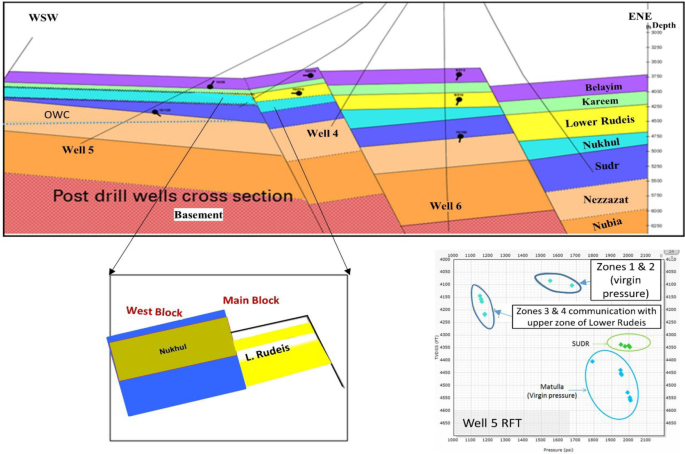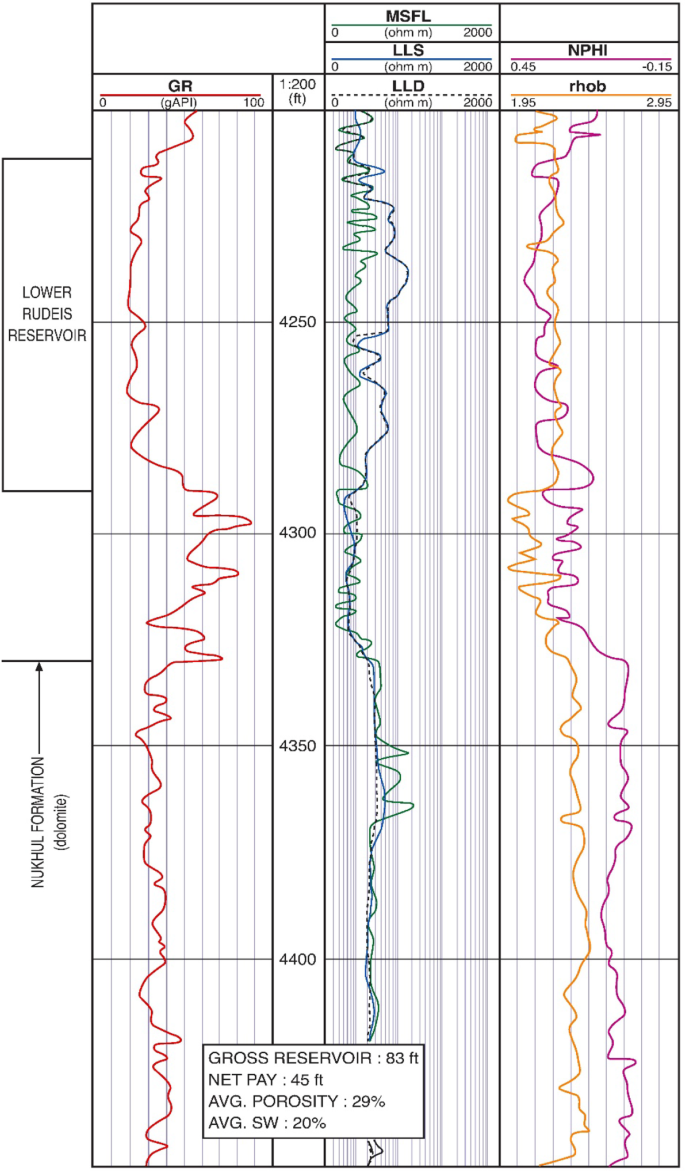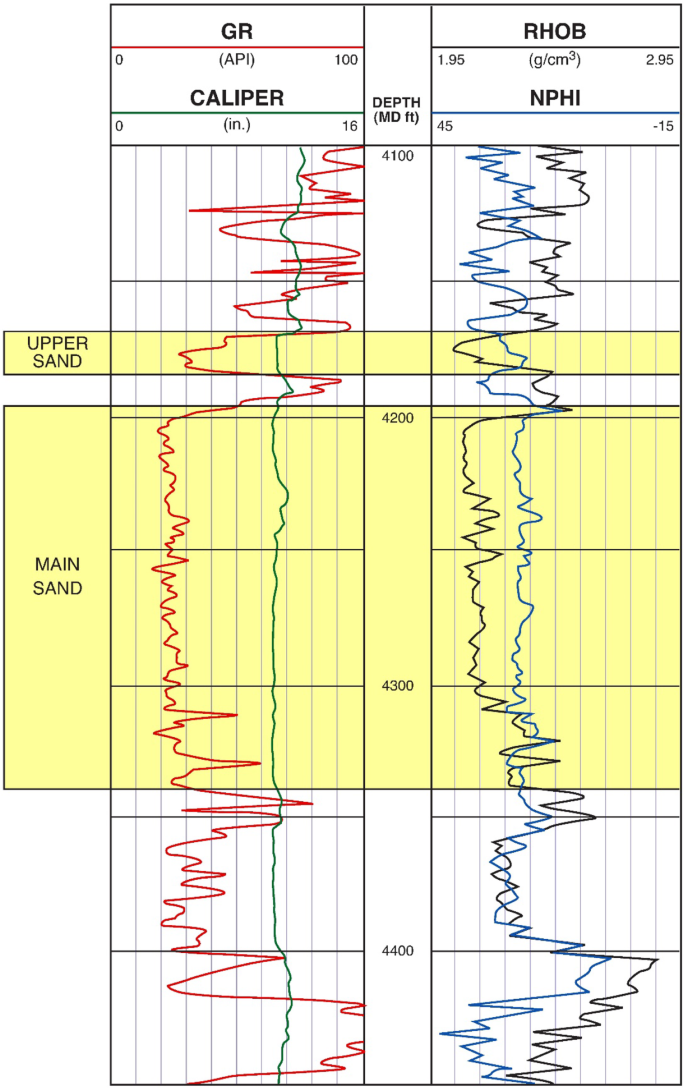Abstract
The discrimination of rock types within the limestones and dolostones of the Nukhul Formation in the West Younis Field (Gulf of Suez Basin, Egypt) presents significant challenges due to their multi-scale compositional and diagenetic heterogeneity, diverse pore types, complex microstructures, and limited core data. This study aims to characterize the carbonate reservoir of the Early Miocene sediments and establish distinct reservoir rock types by employing textural analysis, geological interpretations (i.e., structural interpretation, fracture analysis, reservoir characteristics) using advanced imaging tools, and petrophysical measurements to model porosity/permeability profiles across the reservoir. A new dataset was obtained from the latest exploratory well in the West Younis Field, incorporating microresistivity and acoustic image logs, well logs, nuclear magnetic resonance (NMR) tools, and drill cutting petrographic analysis. The integration of these datasets provided a comprehensive understanding of the properties of the Early Miocene carbonate reservoir. Based on image logs, the carbonate facies were divided into four reservoir units. Petrographic evaluation further classified two facies (A and B) based on diagenetic factors controlling reservoir quality. The results revealed the occurrence of multiple phases of dolomitization, which influenced the reservoir quality. Early-stage dolomitization enhanced reservoir quality, while late-stage idiotopic dolomite crystal growth diminished it. The study also provided comprehensive information on the original rock fabric/texture, diagenetic processes, porosity types and origins, as well as the spatial distribution of pores (permeability index) within this complex carbonate reservoir. By employing an integrated technique, this study successfully differentiated the carbonate reservoir into distinct rock types, leading to improved reservoir characterization and field development. Additionally, the findings contribute valuable insights for the development and exploration of the Early Miocene carbonate section in the southern Gulf of Suez.
Similar content being viewed by others
Avoid common mistakes on your manuscript.
1 Introduction
The carbonate reservoirs in the early Miocene Nukhul Formation in the southern Gulf of Suez, Egypt, often exhibit complex and heterogeneous rock properties, including variations in pore types, pore sizes, and rock textures [1,2,3,4,5]. These heterogeneity poses challenges in accurately characterizing the reservoir and predicting fluid flow behavior [6,7,8,9,10]. Carbonate reservoir heterogeneity can occur at various scales, ranging from well to regional scales. Integrating data from different scales and understanding the relationships between them is essential for reservoir characterization and modeling [3, 5]. Carbonate depositional fabrics undergo modifications through biological, chemical, and physical processes during deposition and subsequent diagenesis [8, 11, 12]. These modifications have a significant influence on pore system characterization and the physical properties of limestones and dolomites, ultimately impacting porosity and permeability [7, 13,14,15]. Rock typing schemes have been developed to establish a framework for rock property modeling using integrated borehole data and 3D static reservoir models [16,17,18,19,20].
The optimum carbonate reservoir characterization requires integration of multiple datasets, including core samples, petrophysical measurements, and logs [3, 8]. Traditional rock typing methods such as Leverett's J-function, Winland's R35, and flow zone indicators are commonly used in conjunction with cored reservoirs [21]. However, in the absence of core data, capturing the heterogeneity of carbonate reservoirs becomes more challenging, necessitating the integration of available data for improved rock classification. In this study, an integration of image analysis, thin section analysis, and borehole logging is employed to enhance our understanding of the pore network characteristics of the Nukhul Formation in Younis Field. The Younis Field, also known as GS 347, is located in the southern part of the Gulf of Suez, less than 3 km from the coast of the Sinai Peninsula (Fig. 1). Discovered in 1981 and brought into production in 1983, the main reservoir in Younis Field is the Lower Miocene Lower Rudeis Formation, which hydraulically connects with the Kareem Formation reservoir in the adjacent SB 339 Field via a non-sealing fault [22]. Minor production has also been observed from the Coniacian–Santonian Matulla Formation and the Lower Miocene (Aquitanian) carbonates of the Nukhul Formation, which are the primary focus of this paper.
The main challenge facing the Nukhul exploration is the reservoir heterogeneity and the lack of understanding the depositional and diagenetic controls on the reservoir properties. This study aims to highlights the tools and workflow that may use to unlock these heterogeneities. Recent exploratory wells drilled in the western part of Younis Field have renewed interest in the exploration and characterization of this carbonate reservoir section, which has previously received limited attention. Despite previous studies investigating the petrographic and sedimentological characteristics of the Nukhul Formation reservoir [4, 23,24,25,26,27], little is known about the reservoir characterization, reservoir compositional and diagenetic heterogeneity, relationship between petrographic characteristics and geophysical log signatures, pore system network, and reservoir quality in the Nukhul Formation of Younis Field, especially with the limited core data.
This research aims to: (i) establish distinct reservoir rock types within the Nukhul Formation carbonates; (ii) perform petrophysical and pore network evaluations to study the impact of diagenetic controls on reservoir quality; (iii) model the porosity/permeability profile along the entire reservoir using textural analysis of advanced image logs, and petrophysical measurements; and (iv) integrate ditch cutting petrographic descriptions and geophysical logs to differentiate the carbonate reservoir into various rock types, enhancing reservoir characterization and field development. To achieve these objectives, specialized petrophysical techniques, including microresistivity and acoustic borehole imaging, nuclear magnetic resonance (NMR), as well as petrographic analysis of original rock fabric/texture, diagenetic processes, and pore network evaluations, were employed. Production logging techniques have also been utilized to explore the carbonate rocks of the Nukhul Formation in the western part of Younis Field and further enhance reservoir development strategies. This research endeavors to contribute valuable insights into the pore network heterogeneity and reservoir characterization of the Nukhul Formation carbonates. The integration of various techniques and datasets will advance our understanding of reservoir properties, aid in accurate reservoir modeling, and facilitate improved field development strategies in carbonate reservoirs.
2 Geological Setting
The Gulf of Suez is a rift basin, approximately 350 km long and 50–80 km wide, trending NNW-SSE (Fig. 1). It is part of the Red Sea rift system, which formed when the African and Arabian plates separated in the late Eocene to Oligocene. The basin's fill, ranging from 10,000 to 16,000 ft (3048–4876.8 m) thick, consists of clastics, carbonates, and evaporites (Fig. 2) [28,29,30,31].
Structurally, the Gulf of Suez is divided into three sub-basins with varying dips and fault directions (Fig. 1) [30,31,32,33,34]. The strata in the Darag sub-basin and the Amal-Zeit province in the north and south, respectively, dip to the SW, while faults dip to the NE [8, 35]. In contrast, the Belayim province in the central region has strata dipping to the NE and faults dipping to the SW. The Zaafarana and Morgan accommodation zones separate these sub-basins. A Miocene biostratigraphic framework has been established, and sequence boundaries have been identified throughout the basin's sedimentary section (Fig. 3) [1, 2, 36,37,38]. The rifting process began around 22–24 million years ago (Aquitanian) with volcanic activity in the Lower Miocene.
Sequence stratigraphy of the Miocene section in the Central and Southern Gulf of Suez [1]. Sequences (S10, S20 etc.) are separated by major, biostratigraphically-defined breaks (T10, T20 etc.). Arrows indicate the main reservoirs in the Younis and SB 339 fields
The basin experienced a transgression during the Miocene, leading to an unconformable contact with rocks from the Precambrian to the Upper Eocene. The earliest synrift sediments consisted of fluvial and shallow marine sandstones, followed by shallow marine limestones, evaporites, and marine marls (Nukhul Formation). Also, deeper marine conditions developed during the Early Miocene due to rapid subsidence and fault block rotation, resulting in the deposition of marls and shales of the Rudeis Formation [5]. The rift margins contain sandstones and turbidites, reflecting the uneven topography. The Younis Field, located in the South Amal-Zeit province, has a stratigraphy that begins with a Precambrian basement overlain by the Nubia Sandstone (Fig. 3). The Nezzazat Group, including the Matulla Formation, overlies the Nubia Formation and has produced small oil volumes from Younis wells A2 and A6 [39]. The Younis Field also contains reefal carbonate sediments and a developed Lower Rudeis clastic reservoir. The lowest synrift unit, the Nukhul Formation, consists of siliciclastic, anhydrite, and highly dolomitic limestone that has produced minor oil in Younis well A2 and is being explored in the west Nukhul block. The ‘G’ horst, where the Younis and SB 339 Fields are situated, was formed during the Miocene rifting of the Gulf of Suez. The horst overlies a NNW-SSE trending high at Precambrian basement level and is characterized by bounding faults and numerous faults within (Figs. 4, 1) [22, 40]. The bounding faults have throws of > 4000 ft (1219.2 m) at pre- Miocene level, and the horst is cut by numerous faults (Fig. 4). The principal source rocks in the vicinity of the fields are the Senonian Brown Limestone and the Eocene Thebes Formation, which were deposited under marine, anoxic conditions and contain abundant kerogen. Oil migration occurred along the bounding faults that formed after the Mid-Rudeis tectonic event in the late Lower Miocene. The Younis Field has a significant oil reserve, with the Lower Rudeis interval being the main oil producer. The field has experienced fluctuations in production over the years, with water injection and other measures implemented to maintain and increase oil recovery [41,42,43].
Structure map of the Younis Field at the top of the Lower Rudeis reservoir, showing well locations (EGPC, 1996; Clark and Hanafy, 1994). E–E′ is the location of seismic section shown in Fig. 7
3 Materials and Methods
3.1 Samples Analysis
Six wells distributed across the Younis Field were studied in this work (Fig. 4). The drill cuttings of the Nukhul Formation have been analyzed for petrographic investigation.
The drilled wet samples were dried and washed to eliminate the drilling mud and filtrates. Thirty polished thin sections were prepared from selected cuttings, using a suitable slab size. The slabs were impregnated with blue dye epoxy for porosity investigation. The samples were studied under Olympus BX 51 microscope [44]. Descriptive petrographic reservoir characteristics are point counted to assess the mineral composition, textural and compositional maturity, and porosity. To reconstruct the paragenetic sequence and establish the impact of diagenesis on the reservoir potential of the examined facies, the distinct diagenetic features, cement types and their morphologies, mineral replacement, and cross-cutting relationships of fractures were researched in detail. For petrographic description and facies, nomenclature was used classifications of Folk [45, 46], Dunham [47], and Flügel and Munnecke [48].
A comprehensive analysis of point counting data from 12 thin sections was done on a random grid of 250 points for each photograph of the thin section. Points were assigned to one of four classes: sparite, micrite, Fe-oxides, and porosity (Table 1). We employed a systematic and standardized approach to gather mineralogical and textural information from the thin sections, ensuring the accuracy and consistency of our measurements. Subsequently, the collected data were processed and statistically evaluated to derive meaningful insights into the geological characteristics of the studied samples.
3.2 Image Log Tools and Analysis
Image logs have played a critical role in reservoir characterization, by providing high-resolution characteristics of carbonates and siliciclastic reservoirs [49,50,51,52]. The Circumferential Acoustic Scanner Tool (CAST™) and the Oil Mud Reservoir Imager (OMRI™) tools were run from the top of the Nukhul Formation covering the total depth (TD) of the exploratory well (well#5).
3.2.1 Acoustic Logs
The CAST tool delivers an ultrasonic (acoustic) image scan of the borehole walls by measuring the amplitude and travel-time of return pulses, which are transmitted 200 times per scanner rotation. Thus, this tool has two image modes: one is the amplitude image, which depends on the acoustic impedance of the formation and the fluid, while the travel-time image mainly depends on the distance between the transmitter and the borehole wall, making it perfect for evaluating hole (or casing) conditions. As the signal is bounced back from the borehole wall, the quality of both image types is very dependent on a smooth and round hole, as well as the tool being perfectly centered. One advantage of this tool is that it provides a complete image of the oil-based mud, which other tools do not support. In this work, the borehole image logs (i.e., CAST) were used to interpret some structural features (i.e., fractures, dip) within the target area, and picking the boundaries and reservoir features followed [53, 54].
3.2.2 Electrical Imager Tool
The image tool in this work was used for identifying structural and stratigraphic dips, borehole stresses, fluid profiles, sedimentary geometry, and texture that are beyond the resolution of conventional logs. In this work, the image logs have been used to pick bedding planes and give information about the structural dip attitude of the picked mudstone/siltstone bed boundary and lamination planes of the studied facies, which is then displayed in the dip azimuth vector.
The OMRI tool is intended for the acquisition of microresistivity borehole images in non-conductive muds [53, 55]. The OMRI™ is an electrical imager tool possessing six arms positioned as 2 sets of 3 arms vertically displaced by approx. 94 cm. Arms 1, 3, and 5 exist at the top, while arms 2, 4, and 6 are located at the bottom. Each arm is affixed to a pad of approx. 30 cm in length that has two transmitter electrodes at each end with six pairs of monitoring electrodes positioned symmetrically between them. A high-frequency measuring current is transmitted to capacitive couple the survey current through the mud and into the wall of the formation. The monitoring electrode pairs then measure the potential difference (due to voltage drop) between them, and Ohm’s law subsequently determines the formation resistivity. This high-resolution image tool is the optimum tool for carbonate reservoir discrimination, where it imaged the reservoir characteristics of pore system types, sedimentological and depositional characteristics that control the reservoir connectivity and deliverability. The two image tools (OMRI and CAST) have been used to investigate the structural features and reservoir characteristics along the studied intervals. Drilling-induced fractures, faults, natural fractures, and breakouts are structural discontinuity-related features in this investigation. The dip angle and azimuth of the aforementioned structural features were measured, and faults and natural fractures were identified in the acoustic image logs based on their continuous sharp edges and distinct dip and azimuth values in comparison with the sedimentary beddings.
3.2.3 Nuclear Magnetic Resonance (NMR)
Nuclear magnetic resonance (NMR) logging measures the magnetic moment induction of protons (hydrogen nuclei) that are preserved in the pores of the reservoir rock. The NMR responses to the rocks and fluid properties show mineralogy dependence [3, 56, 57]. Time-based metrics for reservoir properties, T1 and T2 cutoffs, are utilized as indicators. The NMR equipment combines magnetic fields that are acting directly on the protons in the formation fluid (T2) to detect the protons' polarization time or relaxation time (T1) [2, 57]. For about 350 feet (107 m) of the reservoir section, between 6180 feet (1884 m) and 6530 feet (1990 m), NMR data were available.
4 Results
4.1 Petrographic Analysis
The petrographic analysis of drilling ditch cuttings extracted from six wells revealed that the Nukhul Formation is composed of dolomite and highly dolomitized recrystallized lime-mudstone, varying in thickness from 100 to 150 ft. The Late Aquitanian and Early Burdigalian age of Nukhul Formation in the Younis field is confirmed by the presence of benthic foraminifera Miogypsinoides and nannoplankton zone Triquetrohabdulus carinatus (NN2 Zone), which are correlated with age data of the Nukhul Formation type locality at Gebel el Zeit [58].
According to the petrographic description of the studied thin sections, the carbonate facies are discriminated into two distinctive lithofacies (A and B) (Fig. 5).
Petrographic description of ditch cutting in Well 5 in West Younis field block represents different stages of dolomitization in Facies A and B and its effect on the reservoir quality. ) Facies A: Micritized, idiotopic to hypidiotopic dolostone rhombs (red arrow). The outer rim is outlined by lime mud (black arrow) and traces of iron oxides (white arrow). b Facies A: Photomicrograph present multiphase of dolomitization (yellow arrows). Note that the late phase of dolomitization reduced the porosity (P) due to excessive crystal growth. Also, the outer rim is outlined by lime mud (black arrow). c Facies B: dolomitized vuggy dissolution mudstone with dominant vuggy porosity (blue dye). d Facies B: Intercrystalline and vuggy porosity (P) within the sparry calcite limestone (green arrow). Note that the enhancement in reservoir quality in Facies B that lie above the Paleocene/Eocene major unconformity. The log response reflects the facies variation along the well logs. GR = gamma ray. NPHI = neutron log. RHOB = density log
Facies A is composed of micritized, idiotopic to hypidiotopic dolostone rhombs (Fig. 5). The outer rim is outlined by lime mud and traces of iron oxides. The high percentage of argillaceous micrite has affected the GR log response and increased the shale volume content, while decreasing density log readings (Fig. 5). Facies A in the upper part of the Nukhul Formation lies below the Lower Rudeis unconformity (T10) (Fig. 3).
Facies B represents the lower part of the Nukhul Formation, and it lies above the Paleocene/Eocene major unconformity (T00) (Fig. 3). This facies is dolomitized, vuggy, and crystallized mudstone with dominant vuggy and intercrystalline porosity.
4.2 Reservoir Pore Systems
According to the microscopic characteristics of thin section castings, four main pore types have been identified: interparticle, intraparticle, intercrystalline, and vuggy (Figs. 5, 6, 7).
Interparticle pores are used to describe the pores formed between grains (intergrain), which agrees with the definition provided by Choquette and Pray [59]. Interparticle pores, which primarily occur in Facies A and B, are mostly irregular polygonal shapes. Intraparticle pores are formed by the selective dissolution of interparticle cements. These pores are locally filled with cement, suggesting that they probably formed during early dolomitization [48]. The fine to medium-crystalline dolomite in both Facies A and B exhibits varying degrees of dolomitization, resulting in the observation of intercrystalline pores under the microscope [48]. Within the studied dataset, intercrystalline pores are observed to develop between euhedral dolomite crystals, as illustrated in Fig. 7. Vuggy pores, which are secondary solution pores formed through the dissolution of cement, matrix, and grains, are predominantly present in Facies A and B, with an increased occurrence in Facies B (Fig. 8).
A stacked bar chart of the 12-point counted thin sections (Table 1) show how the porosity changes across the Facies A and B
4.3 Image and NMR Log Analysis
4.3.1 Structural Features Analysis
The image logs picked bedding planes and give information about the structural dip attitude of the picked mudstone/siltstone bed boundary and lamination planes of the studied facies, which is then displayed in the dip azimuth vector (Fig. 9).
Rose and dip azimuth plots representing the dip attitude of the mudstone bed-boundaries and lamination planes picked from the processed imaged rock interval; 6140–7660 ft (1871.5–2334.8 m). They strike generally NNE–SSW and dip mostly due ESE; swinging from SSE to ENE with a calculated mean dip attitude measuring 12°/S69°E
The image structural interpretation included determining the main structural dip attitude (dip magnitude/azimuth) of the study succession; identifying the distribution, orientation, and type of faults and fractures; and assigning the stress field orientation from drilling induced fractures and breakouts. All over the processed imaged interval (6140–7660 ft) (1871.5–7334.8 m), a total of 323 depositional planes of bedded/laminated mud facies (mudstone/siltstone) were picked. They generally strike NNE-SSW and dip mostly due ESE, swinging from SSE to ENE with a calculated mean dip attitude of 12°/S69°E. The dip azimuth vector plot for these picked mud facies planes displays one zone dipping generally due ESE (Fig. 9). In the Nukhul Formation, the structural dip attitude of the picked carbonate and mudstone bed boundary and lamination planes is generally striking NE-SW with a dip attitude of about 12°/S53°E (Fig. 10), and there are also ENE-trending cross-faults, which are parallel to the main bounding faults of the southern part of the Gulf of Suez [60].
Representative snapshots of massive limestone rock unit within the imaged interval of Nukhul Formation (zones 1 and 2). This limestone rock unit interval (6195–6213ft) (1888.2–1893.7 m) is characterized by 6 resistive steeply dipping natural fractures from the OMRI, and they are commonly striking NW–SE and dip mostly due the SW. Two fractures of these analyzed 6 natural resistive fractures show high acoustic impedance contrast (Blue Fracpole), while the rest of these fractures show partial acoustic contrast (Magenta Fracpole). Zone 2 shows the higher permeability with demonstrated vuggy porosity
4.3.2 Fracture Analysis
Fractures picked from the image include the following types of fractures: open, closed, partial open, and induced fractures. The picked fractures were categorized based on the following criteria: (a) natural open fractures are conductive because they are typically filled with drilling mud and appear as darker traces than the formation rock surrounding them. (b) Natural closed fractures have been filled by secondary mineralization, making them more resistant than open fractures, which are typically filled with drilling mud (Figs. 10, 11, 12).
Closed fractures generally appear as traces that are brighter than the surrounding rock and sometimes demonstrate a "halo" appearance due to the resistivity of the secondary mineralization. (c) Natural partially open fractures are closed or partially mineralized. On image logs, they appear as traces that are partially bright and partially dark. (d) Induced fractures occur at various stages of the drilling process. Induced fractures are open fractures, so they will be conductive and show a dark fracture trace. There are different types of induced fractures. Petal and centerline fractures can form ahead of the bit while drilling and are caused by the weight of the bit and/or mud pressure. Tensile fractures can form from hydraulic fracturing with mud behind the bit. Since tensile fractures develop after the wellbore is cut, they develop in isolation and will be asymmetrical.
In the case of imaging holes drilled by oil base mud fluid (as in this study case), the differentiation between open, partially open, and closed fractures is generally very difficult due to the high resistivity of both the invaded drilling fluid in the case of open fractures and the healing occurring by resistive minerals such as quartz and calcite in the closed fractures. That’s why, in such cases, the acoustic image (CAST-open hole mode) in combination with OMRI was run in this studied reservoir since open fractures (fluid-filled) will be easily differentiated with their lower acoustic impedance and slower time relative to closed cemented fractures (calcium or siliceous cement filled). In addition, the petrographic analysis of the drill cuttings has differentiated between the cemented and open fractures. In the studied well, the carbonate section was investigated using the combination of OMRI and CAST for better fracture identification and classification, where the identified fractures could be classified using CAST into fractures with complete/partial acoustic impedance contrast or no acoustic impedance contrast, (closed). Based on the above criteria, along the entire logged interval from 6140 to 7660 ft (1871.5–2334.8 m), 92 natural resistive fractures were identified from the OMRI image (Fig. 9).
In the upper carbonate succession of the Nukhul Formation, the CAST and OMRI were run in combination, and a total of 37 natural fractures were identified (Figs. 10, 11). They are commonly striking NW–SE and dip mostly due SW, with a wide range of dip angle magnitudes that lie between 21° and 85°. The fracture characterization along the Nukhul Formation reveals that the total number of 37 natural resistive fractures comprises five natural resistive fractures with no acoustic impedance contrast, commonly striking NW–SE and dipping mostly due SW, with dip angle magnitudes ranging between 71° and 78°. Twenty-five natural fractures with partial lower acoustic impedance contrast commonly striking NW–SE and dip mostly due SW, with a wide range of dip angle magnitudes that lie between 19° and 85°. Seven natural fractures with acoustic impedance contrast commonly striking NW–SE and dip mostly due SW, with dip angle magnitudes ranging between 55° and 79°.
5 Discussion
5.1 Effects of Sedimentary Environment and Tectonics on Reservoir Quality
The rift initiation stage of the Nukhul Formation leads to variations in the depositional setting and regime of Nukhul from fluvial, fan delta, shallow marine, reefal carbonate, and dolomitized limestone, as discussed by [25, 58]. The Miocene/Eocene unconformity T00 led to areal to sub-areal exposure of the limestone in Younis Field and the southern Gulf of Suez. Therefore, this sub-areal exposure has potential for magnesium-rich freshwater that caused the first phase of diagenesis, as evidenced by Facies B vuggy limestone and dolomitization [25, 58, 61,62,63]. Temraz and Dypvik [25] recorded significant changes in the southwest at Gebel el Zeit highly sandy dolostone in the early stage of rifting.
The findings of this study suggest that the unconformity potentially introduced freshwater into the lower carbonate of the Nukhul Formation, triggering a gradual process of dolomitization that ultimately improved the reservoir quality (Fig. 5), as mentioned in the work of Elshahat [64] and Shallaly and others [65]. Also, the work of Yang and others [63] established a quantification study for dolomitization and its effect on porosity and permeability. Their numerical modeling finds an increase in the effective porosity by 8.5% during dolomitization. These findings match the work of Carr et al. [24] and McClay et al. [23], which proposed the effect of the early rift faults on the deposition of the Nukhul Formation.
The acoustic and microresistivity OMRI and CAST images discriminate the Nukhul carbonate unit into four zones based on the lithological criteria and rock unit characterization. Zone 1 is composed of fractured dolomitic limestone that has an average fracture density of one open fracture per foot. It also has approximately twenty-five naturally occurring resistive fractures with low impedance, most of which dip largely toward the SW and typically have a NW–SE strike. These fractures may result from the Gulf of Suez extension regime and may indicate that they were initiated with the initiation stage of the Gulf of Suez rift, with a wide range of dip magnitudes of 20°–85° (Fig. 10). This zone shows low permeability and is matched with the petrology of Facies A. Zone 2 may be highly karistified dolostone due to T00 unconformity at the initial stage of rifting [66, 67]. This rock unit interval is characterized by dissolution vugs pores, which appear as highly resistive patches with low acoustic impedance (Fig. 10). The dissolution vuggy pores are found to be connected at some intervals. This zone shows the same facies that is recognized by the ditch cutting petrology of Facies B, with a good permeability of 50–100 millidarcy. Zone 3 shows a massive interbedded limestone rock unit that is characterized by dissolution vugs with low acoustic impedance and high resistive patches. These dissolution vug pores are found to be connected to some natural resistive fractures, with an average fracture density of 1.5 open fractures per foot (Fig. 11). The permeability measured by CMR was less than 100 mD (Fig. 11). Zone 3 matched the petrographic description of Facies B. Zone 4 of the Nukhul carbonate unit is characterized by resistive fracture striking, generally due to the SW showing high acoustic contrast (blue flagpole). The presence of fractures filled with silica cement is notable, and their formation is attributed to precipitation in an acidic medium. This phenomenon may have contributed to the development of dissolution porosities within zones 3 and 2. The zone is composed of permeable, vuggy, and dolomitic limestone with a high mud content. Zone 2 and zone 3 show the same lithological criteria as recognized in Facies B (Fig. 12). Two main distinctive zones can be interpreted from the CAST image tool mainly based on the intensity of the vuggy limestone, which is reflected in the permeability derived from the CMR log (Fig. 10). The upper zone of the CAST image is correlated with the Facies A from the petrography analysis, where the permeability displays very low permeability and low mobility of 0–5 Md. On the other hand, the lower zone of the CAST image is correlated with Facies B, with a permeability of 50–100 mD (Fig. 10).
These two zones have the best quality intervals of the Nukhul carbonates. According to the production data, zone 2 is the only zone that contributes to oil production in the Nukhul reservoir, while zone 3 does not. In the case of a non-sealed fault, zone 3's hydrocarbon volume may be shared with another reservoir. The NMR integration with the density/neutron porosity logs shows the hydrocarbon bearing units exhibited at zones 2 and 3 (Fig. 12). These log integrations emphasize that zones 2 and 3 have the highest storage capacity and flow.
Facies B was presented as the best reservoir quality facies due to its intercrystalline and vuggy porosity (Fig. 5). In contrast, the reservoir quality is reduced in Facies A due to multiphase dolomitization (Figs. 5, 6).
5.2 Diagenetic Controls on Reservoir Quality
5.2.1 Effects of Dolomitization
The thin sections display the effect of the dolomitization processes in the Nukhul Formation, where two dolomitization phases affect the reservoir quality (Fig. 5). Dolomitization, calcite cementation, dissolution, and fracturing commonly exert a considerable impact on carbonate reservoir quality, as the major diagenetic processes in carbonate reservoir rocks [2, 68,69,70,71,72].
Early dolomitization enhanced the reservoir's quality by creating intercrystalline porosity. Late stage dolomitization is characterized by the growth of another phase of dolomitization, which has reduced the reservoir quality by reducing the porosity due to crystal growth (Fig. 5). The vuggy porosity in Facies B of the Nukhul Formation demonstrates the dissolution diagenetic process. Furthermore, the selected fractures along Facies B appear to play a role in enhancing the pore system in the Nukhul Formation. Open, closed, partial open, and induced fractures were picked from the image logs in the Nukhul Formation. Therefore, the dolomitization, dissolution, and fracturing processes enhanced the reservoir quality of the Nukhul Facies B that are associated with rifting initiation. The interparticle pores are commonly related to the selective dissolution of cements and matrix, which is strongly controlled by fluid migration pathways and patchy cementation of both primary and secondary interparticle pores [48].
The identified characteristics must be closely monitored throughout the Gulf of Suez basin to effectively pinpoint high-quality reservoirs. On the other hand, a destructive dolomitization feature of diagenesis has been propagated by later stages of diagenesis, leading to more growth of dolomite crystals to reduce the reservoir quality and deliverability of Facies A at the upper part of the Nukhul Formation (Figs. 5, 6, 7) [73,74,75]. Calcite or siliceous cement filled some fractures in both Facies A and B, which led to a decrease in the pore system in some parts.
The study reveals a significant correlation between porosity and micrite content, as demonstrated by the point counting data (Table 1). Within the dataset (Table 1 and Fig. 8), it is evident that Facies A exhibits a pronounced decrease in porosity alongside a high micrite percentage, while Facies B exhibits an inverse trend, highlighting the intricate relationship between micrite and porosity in the Nukhul Formation. These findings underscore the critical role of micrite in governing the porosity variations observed in the investigated rock samples.
Dolomitization is the most important diagenetic process in the Early Miocene Nukhul Formation. Petrographic description of ditch cutting in the studied well 5 in the West Younis field block shows different stages of dolomitization in Facies A and B (Fig. 5). The vuggy pores are affected by near-surface meteoric waters and are related to deep-burial fluids mainly controlled by fractures and faults [76, 77]. The petrographic analysis displays multiphase dolomitization (Fig. 5); the first dolomitization is most likely earlier of diagenesis processes (Fig. 7), which enhances the pore system of the Nukhul carbonate rocks. On the other hand, the late phase of dolomitization started at the late phase of diagenetic processes and reduced the porosity due to dense crystal growth. Thus, dolomitization has dual roles in controlling the reservoir quality of the Nukhul Formation.
5.2.2 Effects of Late Stage Cementation, Dissolution and Fracturing
Cementation is the second most important diagenetic process following dolomitization in the Early Miocene Nukhul Formation. In both Facies A and B, some fractures were filled with calcium or siliceous cement, which caused a reduction in porosity (Fig. 5). As a result, the Nukhul Formation could only accommodate fluid movement at specific moments in time. Pore-filling and fracture-filling cementation play a key role in reservoir quality [2].
Both dissolution and fracturing were recorded in the thin sections of the Early Miocene Nukhul Formation. In Figs. 5, 6, 7, the dissolution resulted in various pores porosity in thin sections, while fracturing was recorded in both image logs and thin sections. Additionally, the late calcite dissolution is responsible for improving reservoir quality by dissolving most of the early calcite cementation and creating new pore spaces [72]. Dissolution and fracturing play a key role in reservoir quality [10, 78,79,80], 2. They affect the pores by spreading within carbonates and considerably enhance reservoir porosity and permeability [3, 79]. Facies B, which lie above the Paleocene/Eocene major unconformity, display enhanced reservoir quality, which is characterized by karistified carbonate at the initiation stage of rifting. This information provides insights about the syntectonic carbonate deposits that can be traced in the southern Gulf of Suez.
5.3 Pore Pressure and Connectivity
The formation pressure tool (RFT) of well 5 displays an initial pressure of about 1600 psi in zones 1 and 2. On the contrary, zones 3 and 4 show communication with Upper Sand at a lower Rudeis pressure of 1150 psi [41, 42] on the down-thrown side of well 5 (Fig. 13). Pressure differences between the zones separated by the mudstone layer, which acts as a permeability barrier, may be correlative across Younis Field.
Structural cross section shows the development of carbonate platform in the west block with cartoon. Note the absence of the Lower Rudeis sandstone reservoir in the West block due to pinching out. In contrast, development of the Nukhul carbonates. Zones 1 and 2 show initial pressure while zones 3 and 4 may communicated with the upper part of Lower Rudeis reservoir and lead to depletion
Based on that, the hydrocarbon production from the carbonates in the West Younis explored block is coming from zone 2 only, which shows initial pressure and isolation from the higher permeability zone of Lower Rudeis sandstone on the down-thrown side of the main Younis area (Fig. 13). The volumetric calculations for zone 2 were done using a drainage radius of 500 m (point of communication with the main field), showing stock tank oil initially in place (STOIIP) of about 10–15 million barrels of oil and a production rate estimated to be 200 barrels of oil daily.
Stratigraphically, the analyzed imaged sedimentary rock succession in Well 5 belongs to the Late Cretaceous–Early Miocene age, and covers, from base to top; Nezzazat Group, Sudr Formation, Esna Shale, Thebes Formation, and Nukhul Formation (Figs. 3, 14). The integrated suite of logs, combined with OMRI/CAST images, aided in the redrawing of a better reservoir understanding. The combination of OMRI/CAST was acquired along the upper carbonate succession for reservoir characterization and identifying the secondary porosities (fractures or/and vugs).
The enhancing and destructive diagenetic features cannot be evaluated by using conventional logging tools. Petrographic analysis and discrimination based on the factors controlling the fluid capacity flow are favorable tools for optimum reservoir discrimination [8, 81, 82]. In the absence of Nukhul cores, the most recent image techniques, such as OMRI and CAST, are recommended for optimum reservoir characterization and discrimination in the oil-based mud condition. The image studies are clearly providing an excellent tool for discriminating the Nukhul carbonate reservoir, where the image tool aids in classifying the Facies B from petrographic description into three distinct reservoir zones (zones 2, 3, and 4). Therefore, we managed to identify the characteristics of each zone and delineate the most productive reservoir zone in the Nukhul carbonate reservoir by integrating the petrographic description, image, and production data. The facies A is characterized by massive/interbedded limestone rock units based on the imaged interval of the Nukhul Formation (Fig. 10). This facies is characterized by natural parallel resistive fractures striking generally NW–SE and mostly due to SW (Fig. 10). The limestone of Facies B is characterized by dissolution vugs that appear as highly resistive patches on OMRI and low acoustic impedance on the CAST, where these possible dissolution vugs are found to be connected at some intervals (Fig. 11). The main natural fractures with low impedance have a strike of NW–SE and dip mostly toward the SW. These fractures exhibit the main dipping regime of the southern area of the Gulf of Suez (Fig. 10).
The integrated suite of logs, combined with OMRI/CAST images, aided in the redrawing of a better reservoir understanding. The combination of OMRI/CAST has been acquired along the upper carbonate succession for reservoir characterization and identifying the secondary porosities (fractures or/and vugs).
5.4 Hydrocarbon Potentiality
The main hydrocarbon pool in the Younis Field is primarily trapped in the Lower Rudeis Formation, extending into the Kareem Formation in the SB 339 Field. The Younis Field also contains minor reserves in the Nubia Sandstone, Matulla Formation, and Nukhul Formation. The Lower Rudeis reservoir's architecture in the Younis Field resembles a layer-cake structure, consisting of two principal pay intervals: the Main Sand and a thinner Upper Sand separated by a shale barrier (Figs. 15, 16).
The Main Sand thickness varies due to pinching out, while the Upper Sand remains relatively constant. The net pay thickness ranges from 6 ft (1.9 m) in the northeast to 199 ft (60.7 m) in the southwest of Younis, with an average of 131 ft. The reservoir exhibits a Net/Gross ratio of approximately 0.6–0.8. The Lower Rudeis reservoir is affected by several faults, with the major NW-trending fault likely acting as a seal, and two ENE-trending faults near well A3 being non-sealing. Exploration in the west block of the main Younis Field revealed the pinching out of the Lower Rudeis Formation, with the development of carbonates and reefs related to the Nukhul Formation, indicating potential as a reservoir. Recent 3-D seismic data, along with improved processing techniques, have enabled the recognition of depositional features, such as fan geometry and subtle onlaps (Fig. 15), providing valuable insights for further evaluation and exploration activities.
6 Conclusions
This work shows how petrology data in integration with logging tools in the lack of cores can quantify the rock types into optimum producing zones, as well as provide insights into the karistified carbonate in the syntectonic carbonate deposits that can be traced in the south Gulf of Suez as high-quality hydrocarbon resources.
The Nukhul Formation shows a challenge in determining the reservoir rock type, reservoir quality, and the variation of quality along Younis field and Gulf of Suez using the conventional subsurface logging. Applying the advanced image logs was able to differentiate the reservoir facies and provide a better understanding the reservoir properties of the studied carbonate section.
The main conclusion from this work is the following:
-
Petrology of the drilling ditch cutting of six wells along the Younis field found two facies, namely Facies A and Facies B. According to petrographic analysis, four main pore types have been identified: interparticle, intraparticle, intercrystalline, and vuggy.
-
Dolomitization, calcite cementation, dissolution, and fracturing commonly exert a considerable impact on the carbonate reservoir quality. The dolomitization and tectonics propagated during the initiation stage of Suez rifting have a positive impact on reservoir development.
-
Integration of petrology with nuclear magnetic resonance (NMR) tool and high-resolution microresistivity acoustic imaging tools addressed hydrocarbon potential and overcame the challenge of distinguishing between various secondary porosities (i.e., vuggy and fractures).
-
Zone 1 and zone 2 in the West block of Younis Field show initial pressure and isolation from the main Younis Field block, which has a very high permeability reservoir in lower Rudeis sandstone. Integrating all the techniques reveals that zone 2 is the produced zone, which is separated from zones 3 and 4 by a permeability barrier layer of mudstone. The detection of a drainage area of 500 m in zone 2 from the point of communication with the main field and a sealed fault found a STOIIP of 15–20 million barrels of oil.
-
The Nukhul has the potential to act as a syntectonic karistified carbonate reservoirs in neighboring areas, where it deserves further exploration in the basin.
References
Ramzy, M.; Steer, B.L.; Abu-Shadi, F.; Schlorholtz, M.; Mika, J.; Dolson, J.; Zinger, M.: Gulf of Suez rift basin models. Part B, Miocene sequence stratigraphy and exploration significance in the central and southern Gulf of Suez. In: Proceedings of the 16th Exploration Conference: Cairo, Egyptian General Petroleum Corporation, pp. 1–7 (1996)
Shehata, A.A.; Kassem, A.A.; Brooks, H.L.; Zuchuat, V.; Radwan, A.E.: Facies analysis and sequence-stratigraphic control on reservoir architecture: example from mixed carbonate/siliciclastic sediments of Raha Formation, Gulf of Suez, Egypt. Mar. Pet. Geol. 131, 105160 (2021)
Radwan, A.E.; Husinec, A.; Benjumea, B.; Kassem, A.A.; Abd El Aal, A.K.; Hakimi, M.H.; Shehata, A.A.: Diagenetic overprint on porosity and permeability of a combined conventional-unconventional reservoir: insights from the Eocene pelagic limestones, Gulf of Suez, Egypt. Mar. Pet. Geol. 146, 105967 (2022)
Farouk, S.; Sen, S.; Saada, S.A.; Eldosouky, A.M.; Elsayed, R.; Kassem, A.A.; Al-Kahtany, K.; Abdeldaim, A.: Characterization of Upper Cretaceous Matulla and Wata clastic reservoirs from October field, Central Gulf of Suez, Egypt. Geomech Geophys Geo-Energy Geo-Resour 9(1), 106 (2023)
Kassem, A.A.: Depositional and diagenetic controllers on the sandstone reservoir quality of the Late Cretaceous sediments, Gulf of Suez Basin. Interpretation 11(2), 1–78 (2023)
Honarpour, M.M.; Nagarajan, N.R.; Orangi, A.; Arasteh, F.; Yao, Z.: Characterization of critical fluid, rock, and rock-fluid properties-impact on reservoir performance of liquid-rich shales. In: SPE Annual Technical Conference and Exhibition?, pp. SPE-158042. SPE (2012)
Tavakoli, V.: Carbonate Reservoir Heterogeneity: Overcoming the Challenges. Springer, Cham (2019)
Radwan, A.E.; Trippetta, F.; Kassem, A.A.; Kania, M.: Multi-scale characterization of unconventional tight carbonate reservoir: insights from October oil filed, Gulf of Suez rift basin, Egypt. J. Pet. Sci. Eng. 197, 107968 (2021)
Radwan, A.E.; Nabawy, B.S.; Kassem, A.A.; Hussein, W.S.: Implementation of rock typing on waterflooding process during secondary recovery in oil reservoirs: a case study, El Morgan Oil Field, Gulf of Suez, Egypt. Nat. Resour. Res. 30(2), 1667–1696 (2021)
Balaky, S.M.; Al-Dabagh, M.M.; Asaad, I.S.; Tamar-Agha, M.; Ali, M.S.; Radwan, A.E.: Sedimentological and petrophysical heterogeneities controls on reservoir characterization of the Upper Triassic shallow marine carbonate Kurra Chine Formation, Northern Iraq: integration of outcrop and subsurface data. Mar. Pet. Geol. 149, 106085 (2023)
Hollis, C.; Vahrenkamp, V.; Tull, S.; Mookerjee, A.; Taberner, C.; Huang, Y.: Pore system characterisation in heterogeneous carbonates: an alternative approach to widely-used rock-typing methodologies. Mar. Pet. Geol. 27(4), 772–793 (2010)
Radwan, A.E.; Kassem, A.A.; Kassem, A.: Radwany Formation: a new formation name for the Early-Middle Eocene carbonate sediments of the offshore October oil field, Gulf of Suez: contribution to the Eocene sediments in Egypt. Mar. Pet. Geol. 116, 104304 (2020)
Barbier, M.; Hamon, Y.; Callot, J.P.; Floquet, M.; Daniel, J.M.: Sedimentary and diagenetic controls on the multiscale fracturing pattern of a carbonate reservoir: the Madison Formation (Sheep Mountain, Wyoming, USA). Mar. Pet. Geol. 29(1), 50–67 (2012)
Xiong, Y.; Tan, X.; Dong, G.; Wang, L.; Ji, H.; Liu, Y.; Wen, C.: Diagenetic differentiation in the Ordovician Majiagou Formation, Ordos Basin, China: facies, geochemical and reservoir heterogeneity constraints. J. Pet. Sci. Eng. 191, 107179 (2020)
Al-Ramadan, K.; Koeshidayatullah, A.; Cantrell, D.; Swart, P.K.: Impact of basin architecture on diagenesis and dolomitization in a fault-bounded carbonate platform: outcrop analogue of a pre-salt carbonate reservoir, Red Sea rift, NW Saudi Arabia. Pet. Geosci. 26(3), 448–461 (2020)
Skalinski, M.; Kenter, J.A.: Carbonate petrophysical rock typing: integrating geological attributes and petrophysical properties while linking with dynamic behaviour. Geol. Soc. Lond. Spec. Publ. 406(1), 229–259 (2015)
Mirzaei-Paiaman, A.; Ostadhassan, M.; Rezaee, R.; Saboorian-Jooybari, H.; Chen, Z.: A new approach in petrophysical rock typing. J. Pet. Sci. Eng. 166, 445–464 (2018)
Riazi, Z.: Application of integrated rock typing and flow units identification methods for an Iranian carbonate reservoir. J. Pet. Sci. Eng. 160, 483–497 (2018)
Safa, M.G.; Nabawy, B.S.; Basal, A.M.; Omran, M.A.; Lashin, A.: Implementation of a petrographical and petrophysical workflow protocol for studying the impact of heterogeneity on the rock typing and reservoir quality of reefal limestone: a case study on the nullipore carbonates in the Gulf of Suez. Acta Geol. Sin.-Engl. Ed. 95(5), 1746–1762 (2021)
Mishra, A.; Kurtev, K.D.; Haese, R.R.: Composite rock types as part of a workflow for the integration of mm-to cm-scale lithological heterogeneity in static reservoir models. Mar. Pet. Geol. 114, 104240 (2020)
Darling, T.: Well Logging and Formation Evaluation, p. 326. UK Elsevier, Oxford (2005)
EGPC: Gulf of Suez Oil Fields (A Comprehensive Overview). Egyptian General Petroleum Corporation, Cairo (1996)
McClay, K.R.; Nichols, G.J.; Khalil, S.M.; Darwish, M.; Bosworth, W.: Extensional tectonics and sedimentation, eastern Gulf of Suez, Egypt. In: Sedimentation and Tectonics in Rift Basins Red Sea: Gulf of Aden, pp. 223–238. Springer, Dordrecht (1998)
Carr, I.D.; Gawthorpe, R.L.; Jackson, C.A.; Sharp, I.R.; Sadek, A.: Sedimentology and sequence stratigraphy of early syn-rift tidal sediments: the Nukhul Formation, Suez Rift, Egypt. J. Sediment. Res. 73(3), 407–420 (2003)
Temraz, M.; Dypvik, H.: The lower miocene Nukhul Formation (Gulf of Suez, Egypt): microfacies and reservoir characteristics. J. Pet. Explor. Prod. Technol. 8(1), 85–98 (2018)
Abuhagaza, A.: Sandstone reservoir assessment of Nukhul Formation using well logging analysis, Eastern Gulf of Suez, Egypt. J. Pet. Min. Eng. 24(2), 1–9 (2023)
Ayyad, H.M.; Hewaidy, A.G.A.; Omar, M.; Fathy, M.: Sequence stratigraphy and reservoir quality of the Gulf of Suez syn-rift deposits of the Nukhul formation: implications of rift initiation and the impact of eustacy and tectonic on deposition. Mar. Pet. Geol. 156, 106459 (2023)
Sellwood, B.W.; Netherwood, R.E.: Facies evolution in the Gulf of Suez area: sedimentation history as an indicator of rift initiation and development (1984)
Darwish, M.; El-Azabi, M.: Contributions to Miocene sequences along the western coast of the Gulf of Suez, Egypt. Egypt. J. Geol. 37(1), 21–47 (1993)
Alsharhan, A.S.; Salah, M.G.: Geology and hydrocarbon habitat in rift setting: northern and central Gulf of Suez, Egypt. Bull. Can. Pet. Geol. 43, 156–176 (1995)
Kassem, A.A.; Sharaf, L.M.; Baghdady, A.R.; El-Naby, A.A.: Cenomanian/Turonian oceanic anoxic event 2 in October oil field, central Gulf of Suez, Egypt. J. Afr. Earth Sci. 165, 103817 (2020)
Patton, T.L.; Moustafa, A.R.; Nelson, R.A.; Abdine, S.A.: Tectonic evolution and structural setting of the Suez rift: chapter 1: part I. Type basin: Gulf of Suez (1994)
Kassem, A.A.; Radwan, A.E.; Santosh, M.; Hussein, W.S.; Abdelghany, W.K.; Fea, I.; Abioui, M.; Mansour, M.H.: Sedimentological and diagenetic study of mixed siliciclastic/carbonate sediments in the propagation stage of Gulf of Suez Rift basin, Northeastern Africa: controls on reservoir architecture and reservoir quality. Geomech. Geophys. Geo-Energy Geo-Resour. 8(6), 1–32 (2022)
Shehata, A.A.; Tahoun, S.S.; Kassem, A.A.; Abdelsamea, E.G.; Hassan, H.F.: Palynostratigraphy and paleoenvironmental inferences of the Jurassic successions, Darag Basin, Gulf of Suez, Egypt. J. Afr. Earth Sci. 200, 104890 (2023)
Younes, A.I.; McClay, K.: Development of accommodation zones in the Gulf of Suez-Red Sea rift, Egypt. AAPG Bull. 86(6), 1003–1026 (2002)
Dolson, J.C.; Steer, B.; Garing, J.; Osborne, G.; Gad, A.; Amr, H.; Mika, J.: 3-D seismic and workstation technology bring technical revolution to The Gulf of Suez petroleum company. Lead. Edge 16(12), 1809–1818 (1997)
Kassem, A.A.; Sen, S.; Radwan, A.E.; Abdelghany, W.K.; Abioui, M.: Effect of depletion and fluid injection in the mesozoic and paleozoic sandstone reservoirs of the October oil field, central Gulf of Suez Basin: implications on drilling, production and reservoir stability. Nat. Resour. Res. 30(3), 2587–2606 (2021)
Wescott, W.A.; Krebs, W.N.; Dolson, J.C.; Karamat, S.A.; Nummedal, D.: Rift basin sequence stratigraphy: some examples from the Gulf of Suez. GeoArabia 1(2), 343–358 (1996)
Shogaa, A.M.; Tawfik, Y.A.: Marginal Fields/Reserves Development: Proceedings 12th Exploration & Production Conference, Cairo: EGPC, Production, vol. 2, pp. 360–364 (1994)
Elshahawi, H.; Gad, K.: Optimizing water injection performance using cased hole spectroscopy and production monitoring logs. In: SPWLA 42nd Annual Logging Symposium. OnePetro (2001)
Clark, T.; Hanafy, H.H.: Younis Field Waterflood Feasibility Study: Proceedings 12th Exploration & Production Conference, Cairo: EGPC, Production, vol. 2, pp. 131–145 (1994)
Clark, T.; Hanafy, H.H.: An innovative secondary recovery approach for a marginal reservoir, SPE Middle East Oil Show, Bahrain: SPE Paper 29779, pp. 101–114 (1995)
Sharaf, L.M.; El Leboudy, M.M.; Shahin, A.N.: Oil families and their potential sources in the southern Gulf of Suez. Pet. Sci. Technol. 25, 539–559 (2007)
Emery, D.; Robinson, A.G.: Inorganic Geochemistry: Application to Petroleum Geology, p. 254. Blackwell, Oxford (1993)
Folk, R.L.: Practical petrographic classification of limestones. AAPG Bull. 43(1), 1–38 (1959)
Folk, R.L.: Spectral subdivision of limestone types, pp. 62–84 (1962)
Dunham, R.J.: Classification of carbonate rocks according to depositional textures (1962)
Flügel, E.; Munnecke, A.: Microfacies of Carbonate Rocks: Analysis, Interpretation and Application, Vol. 976, p. 2004. Springer, Berlin (2010)
Lai, J.; Wang, G.; Wang, S.; Cao, J.; Li, M.; Pang, X.; Qin, Z.: A review on the applications of image logs in structural analysis and sedimentary characterization. Mar. Pet. Geol. 95, 139–166 (2018)
Hassan, S.; Darwish, M.; Tahoun, S.S.; Radwan, A.E.: An integrated high-resolution image log, sequence stratigraphy and palynofacies analysis to reconstruct the Albian-Cenomanian basin depositional setting and cyclicity: insights from the southern Tethys. Mar. Pet. Geol. 137, 105502 (2022)
Hassan, S.; Tahoun, S.; Darwish, M.; Bosworth, W.; Radwan, A.E.: The Albian-Cenomanian boundary on the southern Tethyan margin: Abu Gharadig Basin, Northern Western Desert, Egypt. Mar. Pet. Geol. 154, 106334 (2023)
Bashmagh, N.M.; Lin, W.; Murata, S.; Yousefi, F.; Radwan, A.E.: Magnitudes and orientations of present-day in-situ stresses in the Kurdistan region of Iraq: insights into combined strike-slip and reverse faulting stress regimes. J. Asian Earth Sci. 239, 105398 (2022)
Babasafari, A.A.; Chinelatto, G.F.; Vidal, A.C.: Fault and fracture study by incorporating borehole image logs and supervised neural network applied to the 3D seismic attributes: a case study of pre-salt carbonate reservoir, Santos Basin, Brazil. Pet. Sci. Technol. 40(12), 1492–1511 (2022)
Baouche, R.; Sen, S.; Radwan, A.E.; Abd El Aal, A.: In situ stress determination based on acoustic image logs and borehole measurements in the In-Adaoui and Bourarhat Hydrocarbon Fields, Eastern Algeria. Energies 16(10), 4079 (2023)
Zhao, L.; Nasser, M.; Han, D.H.: Quantitative geophysical pore-type characterization and its geological implication in carbonate reservoirs. Geophys. Prospect. 61(4), 827–841 (2013)
Woessner, D.E.: The early days of NMR in the Southwest. Concepts Magn. Reson. Educ. J. 13(2), 77–102 (2001)
Elsayed, M.; Isah, A.; Hiba, M.; Hassan, A.; Al-Garadi, K.; Mahmoud, M.; Radwan, A.E.: A review on the applications of nuclear magnetic resonance (NMR) in the oil and gas industry: laboratory and field-scale measurements. J. Pet. Explor. Prod. Technol. 12(10), 2747–2784 (2022)
Winn, R.D., Jr.; Crevello, P.D.; Bosworth, W.: Lower Miocene Nukhul Formation, Gebel el Zeit, Egypt: model for structural control on early synrift strata and reservoirs, Gulf of Suez. AAPG Bull. 85(10), 1871–1890 (2001)
Choquette, P.W.; Pray, L.C.: Geologic nomenclature and classification of porosity in sedimentary carbonates. AAPG Bull. 54(2), 207–250 (1970)
Evans, A.L.: Miocene sandstone provenance relations in the Gulf of Suez: insights into synrift unroofing and uplift history. AAPG Bull. 74(9), 1386–1400 (1990)
Machel, H.G.; Mountjoy, E.W.: Chemistry and environments of dolomitization—a reappraisal. Earth Sci. Rev. 23(3), 175–222 (1986)
Meyers, W.J.; Lu, F.H.; Zachariah, J.K.: Dolomitization by mixed evaporative brines and freshwater, Upper Miocene carbonates, Nijar, Spain. J. Sediment. Res. 67(5), 898–912 (1997)
Yang, L.; Yu, L.; Chen, D.; Liu, K.; Yang, P.; Li, X.: Effects of dolomitization on porosity during various sedimentation-diagenesis processes in carbonate reservoirs. Minerals 10(6), 574 (2020)
Elshahat, O.R.: Diagenesis and reservoir quality of the Nubia sandstone and Nukhul formations in Zeit Bay oil field, Gulf of Suez, Egypt. Sedimentol. J. Egypt 23, 17–32 (2017)
Shallaly, N.A.; Beier, C.; Haase, K.M.; Hammed, M.S.: Petrology and geochemistry of the Tertiary Suez rift volcanism, Sinai, Egypt. J. Volcanol. Geotherm. Res. 267, 119–137 (2013)
Zaid, S.M.: Provenance, diagenesis, tectonic setting and geochemistry of Rudies sandstone (lower Miocene), Warda Field, Gulf of Suez, Egypt. J. Afr. Earth Sci. 66, 56–71 (2012)
El Naby, A.I.A.; El-Aal, M.A.: Tectono-sedimentary evolution of active extensional basins controlling the deposition of the Middle Miocene Kareem Formation, southwestern Gulf of Suez, Egypt. Arab. J. Geosci. 9, 1–14 (2016)
Rahimpour-Bonab, H.; Esrafili-Dizaji, B.; Tavakoli, V.: Dolomitization and anhydrite precipitation in permo-triassic carbonates at the South Pars gasfield, offshore Iran: controls on reservoir quality. J. Pet. Geol. 33(1), 43–66 (2010)
Lai, J.; Wang, S.; Zhang, C.; Wang, G.; Song, Q.; Chen, X.; Yuan, C.: Spectrum of pore types and networks in the deep Cambrian to Lower Ordovician dolostones in Tarim Basin, China. Mar. Pet. Geol. 112, 104081 (2020)
Lai, J.; Liu, S.; Xin, Y.; Wang, S.; Xiao, C.; Song, Q.; Ding, X.: Geological-petrophysical insights in the deep Cambrian dolostone reservoirs in Tarim Basin, China. AAPG Bull. 105(11), 2263–2296 (2021)
Boutaleb, K.; Baouche, R.; Sadaoui, M.; Radwan, A.E.: Sedimentological, petrophysical, and geochemical controls on deep marine unconventional tight limestone and dolostone reservoir: insights from the Cenomanian/Turonian oceanic anoxic event 2 organic-rich sediments, Southeast Constantine Basin, Algeria. Sediment. Geol. 429, 106072 (2022)
Ullah, S.; Hanif, M.; Radwan, A.E.; Luo, C.; Rehman, N.U.; Ahmad, S.; Ashraf, U.: Depositional and diagenetic modeling of the Margala Hill Limestone, Hazara area (Pakistan): implications for reservoir characterization using outcrop analogues. Geoenergy Sci. Eng. 224, 211584 (2023)
Nordeng, S.H.; Sibley, D.F.: A crystal growth rate of equation for ancient dolomites; evidence for millimeter-scale flux-limited growth. J. Sediment. Res. 66(3), 477–481 (1996)
Kaczmarek, S.E.: Crystal Growth Mechanisms in Natural and Synthetic Dolomite: Insight into Dolomitization Kinetics. Michigan State University, East Lansing (2005)
Sánchez-Jiménez, P.E.; Valverde, J.M.; Perejón, A.; de la Calle, A.; Medina, S.; Pérez-Maqueda, L.A.: Influence of ball milling on CaO crystal growth during limestone and dolomite calcination: effect on CO2 capture at calcium looping conditions. Cryst. Growth Des. 16(12), 7025–7036 (2016)
Saller, A.H.; Budd, D.A.; Harris, P.M.: Unconformities and porosity development in carbonate strata: ideas from a Hedberg conference. AAPG Bull. 78(6), 857–872 (1994)
Lønøy, A.: Making sense of carbonate pore systems. AAPG Bull. 90(9), 1381–1405 (2006)
Morse, J.W.; Arvidson, R.S.: The dissolution kinetics of major sedimentary carbonate minerals. Earth Sci. Rev. 58(1–2), 51–84 (2002)
Radwan, A.E.: Modeling the depositional environment of the sandstone reservoir in the Middle Miocene Sidri Member, Badri Field, Gulf of Suez Basin, Egypt: integration of gamma-ray log patterns and petrographic characteristics of lithology. Nat. Resour. Res. 30(1), 431–449 (2021)
Radwan, A.A.; Nabawy, B.S.; Kassem, A.A.; Elmahdy, M.: An integrated workflow for seismic interpretation, petrophysical and petrographical characterization for the clastic Mangahewa reservoir in Pohokura gas field, Taranaki Basin, New Zealand. Geoenergy Sci. Eng. 229, 212117 (2023)
Nabawy, B.S.; Al-Azazi, N.A.: Reservoir zonation and discrimination using the routine core analyses data: the upper Jurassic Sab’atayn sandstones as a case study, Sab’atayn basin, Yemen. Arab. J. Geosci. 8(8), 5511–5530 (2015)
Kassem, A.; Hemdan, K.; Sakr, S.; Reda, O.; Saad, A.: Integration of petrology and petrophysical rock typing for optimum reservoir zonation and permeability prediction-case study: north Gulf of Suez, Egypt. In: Offshore Mediterranean Conference and Exhibition. OnePetro (2017)
Acknowledgements
Authors express their sincere gratitude to Dr. Bassam El Ali and the handling editor for the excellent editorial handling. The three anonymous reviewers are thanked for their constructive comments which benefited and enhanced our manuscript. The authors thank the Egyptian General Petroleum Corporation (EGPC) and Gulf of Suez Petroleum Company (GUPCO) for providing the samples in six wells, well logs and images for well 5. Dr. Radwan is thankful to the Priority Research Area Anthropocene under the program “Excellence Initiative—Research University” at the Jagiellonian University in Kraków, Poland.
Author information
Authors and Affiliations
Corresponding author
Rights and permissions
Open Access This article is licensed under a Creative Commons Attribution 4.0 International License, which permits use, sharing, adaptation, distribution and reproduction in any medium or format, as long as you give appropriate credit to the original author(s) and the source, provide a link to the Creative Commons licence, and indicate if changes were made. The images or other third party material in this article are included in the article's Creative Commons licence, unless indicated otherwise in a credit line to the material. If material is not included in the article's Creative Commons licence and your intended use is not permitted by statutory regulation or exceeds the permitted use, you will need to obtain permission directly from the copyright holder. To view a copy of this licence, visit http://creativecommons.org/licenses/by/4.0/.
About this article
Cite this article
Kassem, A.A., Abdel Fattah, M., Hassan, Z. et al. Reservoir Rock Discrimination Based on Integrated Image Logs and Petrographic Analysis: A Case Study from the Early Miocene Nukhul Carbonate, Southern Gulf of Suez, Egypt. Arab J Sci Eng (2024). https://doi.org/10.1007/s13369-024-09173-5
Received:
Accepted:
Published:
DOI: https://doi.org/10.1007/s13369-024-09173-5


